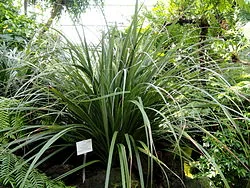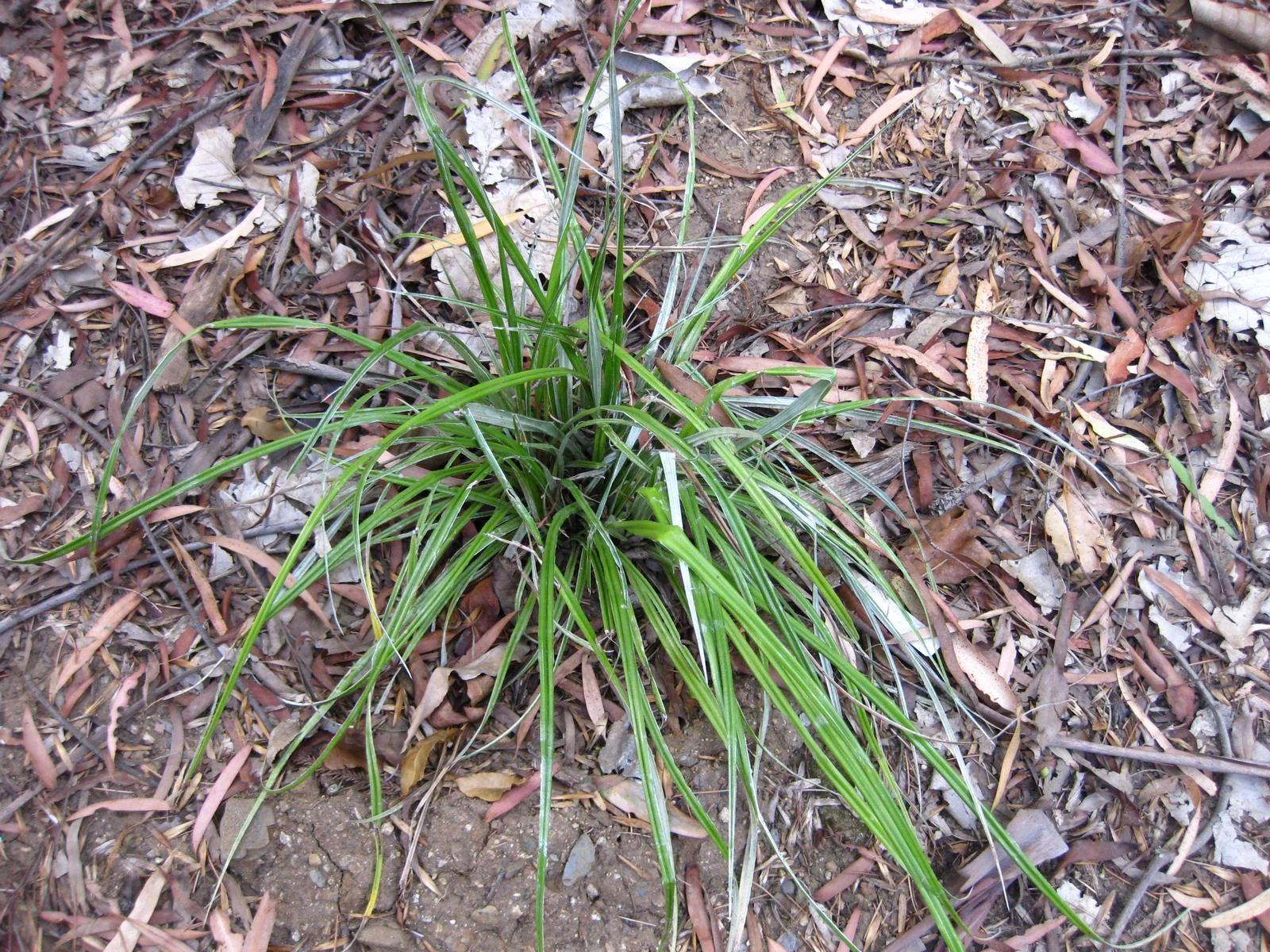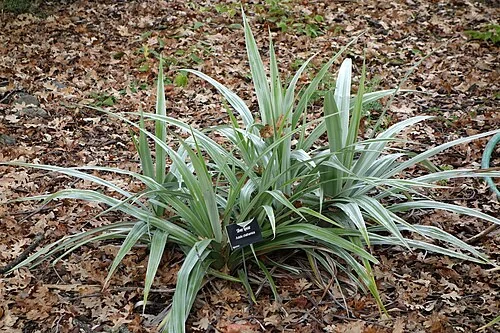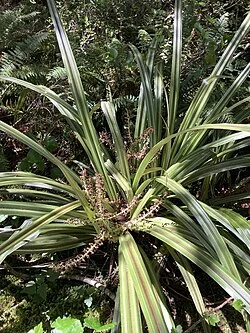
Perching Lily
Astelia solandri
Explore more NZ native plant guides in our index .
Introduction
About Perching Lily
Astelia solandri , commonly known as Perching Lily or K wharawhara, is a distinctive epiphytic plant native to New Zealand. It forms large, architectural clumps of sword-shaped leaves that are typically green with a silvery sheen on the undersides. In spring, it produces inconspicuous flowers followed by attractive orange berries in autumn. This plant is highly valued for its dramatic foliage and is a prominent feature of coastal and lowland forests.

Plant Description
Botanical Features
Astelia solandri , commonly known as Perching Lily or K wharawhara, is a striking epiphytic perennial native to New Zealand. It forms large, dramatic clumps of long, sword-shaped leaves that can reach over a meter in length. The foliage is a bright, glossy green, often with a silvery sheen on the undersides, creating a distinctive architectural feature in its forest habitat. This plant is typically found growing on trees or coastal cliffs, where its roots anchor it firmly while its leaves channel water and nutrients to the centre of the plant. In spring, it produces panicles of small, inconspicuous flowers, which are followed by small, fleshy, orange berries that are an important food source for native birds.
Quick Facts
Plant Summary
| Scientific Name | Astelia Solandri |
|---|---|
| Height | 0.5-1.5 m |
| Spread | 1-2 m |
| Water Needs | Moderate to high; prefers consistently moist conditions |
| Light | Partial shade to full shade |
| Frost Tolerance | Moderate |
| Salt Tolerance | High |
| Growth Rate | Moderate |
| Lifespan | Perennial |
Climate Best Suited to
Astelia solandri is found throughout New Zealand in coastal and lowland forests, often growing as an epiphyte on trees or on coastal cliffs. It thrives in a mild, humid climate with consistent moisture and protection from strong winds and direct sunlight.
Regional Suitability
| Whangārei | Ideal |
| Auckland | Ideal |
| Hamilton | Suitable |
| Rotorua | Suitable |
| Tauranga | Ideal |
| Gisborne | Ideal |
| New Plymouth | Ideal |
| Whanganui | Ideal |
| Palmerston North | Suitable |
| Napier | Ideal |
| Wellington | Ideal |
| Nelson | Ideal |
| Christchurch | Suitable |
| Dunedin | Suitable |
| Invercargill | Suitable |
| City | Climate Suitability |
|---|
Habitat
Natural Distribution
Astelia solandri , also known as Perching Lily or Bush Astelia (k wharawhara in Te Reo Māori), is an evergreen perennial native to New Zealand. Its natural habitat includes humid coastal and lowland forests and coastal cliffs. It commonly grows epiphytically, perching on sturdy branches of mature trees such as kāmahi, or as a lithophyte, occupying crevices on shaded cliffs. While primarily epiphytic, it can also be found growing on damp forest floors. This plant thrives in humid air and filtered light, relying on accumulated organic litter rather than deep soil. It is most widely distributed in lowland forests of New Zealand's North Island and western South Island.
Plant Conservation
Threats and Efforts
Perching Lily ( Astelia solandri ), also known as k wharawhara, is a native New Zealand epiphyte with a national conservation status of "Not Threatened." This classification reflects its widespread distribution across the North, South, and Stewart Islands, as well as its presence in other global regions.
Despite its secure national status, local conservation efforts are important to protect its diverse habitats, which include coastal and lowland forests, and shaded cliff crevices. While the species is resilient, it can be vulnerable to habitat degradation, deforestation, and changes in humidity levels due to environmental shifts. Its unique epiphytic lifestyle makes it particularly sensitive to the health of its host trees and the surrounding forest ecosystem. Conservation efforts focus on preserving its natural forest environments from degradation and managing invasive species. Its popularity in cultivation also contributes to its conservation by raising awareness and ensuring its continued presence in gardens. By supporting the protection of its natural environments and promoting responsible cultivation, we can help safeguard this unique and beautiful component of New Zealand's flora.
Growing Requirements
Soil Requirements
Prefers moist, well-drained, humus-rich soil. When grown as an epiphyte, it requires a substrate that retains moisture.
Light Requirements
Thrives in partial to full shade. Avoid direct sunlight, which can scorch the leaves.
Water Requirements
Requires consistent moisture, especially during dry periods. Do not allow the substrate to dry out completely.
Planting Guide
-
When to Plant
Plant in autumn or spring.
-
Site Preparation
Choose a shady site with moist, well-drained, humus-rich soil.
-
Planting and Aftercare
Dig a hole twice the width of the root ball. Place the plant in the hole and backfill with soil. Water well and apply a layer of mulch.
Ecological Significance
Astelia solandri , also known as Perching Lily or Bush Astelia, holds significant ecological importance in New Zealand's coastal and lowland forests. This evergreen perennial primarily grows as an epiphyte on mature trees or as a lithophyte on shaded cliffs, playing a crucial role in its ecosystem. Its ecological significance stems from several factors: habitat creation and biodiversity, as it contributes to epiphytic communities by moderating humidity and capturing organic matter that would otherwise fall to the forest floor. This process expands available niches and enhances biodiversity within these ecosystems. These "nest epiphytes" can also support other perching plants. It also plays a role in nutrient cycling and moisture retention, as the plant's rosette structure effectively traps fallen leaves and other organic debris, gradually forming a humus-rich pocket. This accumulation helps retain moisture and nutrients, contributing to the overall nutrient cycling within its habitat. As a food source and for seed dispersal, Astelia solandri produces colourful berries that serve as a food source for native birds, which in turn aid in the dispersal of its seeds. By inhabiting elevated microhabitats, the plant adds vertical complexity to forest structures, providing shelter and supporting small invertebrates within its layered foliage. Although widespread in appropriate habitats, the conservation of Astelia solandri is linked to the protection of the old-growth forest trees and cliff vegetation where it naturally thrives.
Uses and Significance
Garden Uses
- An excellent architectural plant for shady borders, woodland gardens, and as an epiphyte on trees or logs.
- Its silvery foliage provides year-round interest.
Cultural Significance
Traditional Uses and Values
Perching Lily ( Astelia solandri ), or k wharawhara, was traditionally used by Māori for various purposes. The leaves were used for weaving, and the berries were a food source. The plant also had medicinal uses in rongoā (traditional Māori medicine).
Landscaping Uses
Garden Design Applications
Astelia solandri , also known as Perching Lily or K wharawhara, is a versatile native New Zealand plant with several landscaping applications, primarily valued for its architectural foliage and ability to thrive in shaded environments. Key landscaping uses for Astelia solandri include: statement specimen (as a striking container plant on shaded patios, or mounted in custom baskets and crevice planters to emulate its natural epiphytic growth habit), architectural accent (its strong form and dramatic rosettes of long, sword-shaped leaves provide bold architectural accents, making it a primary design element in contemporary and naturalistic garden styles), textural contrast (pairs well with other shade-loving plants like tree ferns, kawakawa, and shade grasses, creating layered and textural compositions), underplanting (ideal for underplanting in native or woodland-style gardens, adding texture to shaded and sheltered landscapes), low-light and rock gardens (its tolerance for low-light conditions makes it suitable for rock gardens and other areas with limited sunlight), ponds and pool areas (also listed as suitable for planting around ponds and pool areas), and ecological and native gardens (contributes to biodiversity and can be incorporated into designed landscapes that aim to reference forest ecosystems and cultural narratives; its berries also attract birds). For successful cultivation in landscaping, Astelia solandri prefers partial to bright shade, moist, free-draining, humus-rich soils, and a sheltered environment, avoiding full sun and exposed sites.
Seasonal Care Calendar
Spring
- Apply a layer of compost or leaf mould to enrich the soil and retain moisture.
Summer
- Water regularly, especially during dry periods.
Autumn
- The berries will ripen and provide a food source for birds.
Winter
- Protect from heavy frosts in colder regions.
Pruning
Tidying
As a perching lily (epiphyte), it holds onto old leaves. In a garden setting, manually pull off the brown, dead leaves from the base to reveal the clean fan shape of the plant.
How to Grow Perching Lily
Seeds
Seed propagation is the natural reproduction method for Perching Lily, mimicking the species' remarkable ability to establish new colonies through bird-dispersed seeds in forest canopies and rocky outcrops. This epiphytic species produces fleshy berries that are consumed by native birds, which then disperse the seeds to suitable growing locations throughout the forest ecosystem. For cultivation purposes, seeds can be obtained from commercial suppliers specializing in New Zealand native plants, typically sold in packets of 100 seeds for propagation projects. The significant advantage of Astelia solandri seeds is that they require no pre-treatment and can be sown directly from the packet, making them much easier to handle than many other native species. Sow fresh seeds in a well-draining, coarse growing medium that replicates the epiphytic conditions this species naturally encounters, such as a mixture of bark chips, sphagnum moss, and perlite. The growing medium should provide excellent drainage while retaining some moisture, as waterlogged conditions are fatal to this species which has evolved to grow with its roots never sitting in wet soil. Maintain consistently moist but not wet conditions in a bright, indirect light environment that simulates the dappled forest light conditions where this species naturally thrives. Germination typically occurs within 4-8 weeks under suitable conditions, though some seeds may take longer to emerge. Young seedlings develop slowly initially, forming small rosettes of the characteristic silvery-backed leaves before developing the more substantial root systems needed for their epiphytic lifestyle. Keep seedlings in well-draining conditions and gradually acclimatize them to the growing conditions where they will be permanently established. This method is particularly valuable for conservation purposes and for gardeners wanting to establish this increasingly rare species in suitable forest garden environments where it can perform its natural ecological role.
Division
Division offers a reliable propagation method for established Perching Lily clumps, though it requires careful handling due to the specialized root system adapted for epiphytic growth conditions. This method is particularly valuable when working with mature specimens that have developed multiple growing points or when trying to establish new plants in specific locations where the parent plant has proven successful. The optimal timing for division is during late winter to early spring when new growth is beginning to emerge, allowing divided sections to establish quickly in favorable conditions. Begin by carefully removing the plant from its growing medium or natural perch, taking extreme care to preserve the specialized root system that has adapted to life without soil. Perching Lily develops a network of thick, fleshy roots designed to absorb moisture and nutrients from the air and organic debris rather than from traditional soil, making the root system both crucial and fragile. Once exposed, examine the plant carefully to identify natural division points where separate crowns or growing centers have developed. Use a clean, sharp knife to cut through connecting tissue, ensuring each division includes both healthy roots and at least one complete rosette of leaves with intact growing points. Each division should be substantial enough to support the plant's specialized water and nutrient requirements, as smaller divisions may struggle to establish in the challenging conditions this epiphyte naturally inhabits. Immediately replant divisions in a very well-draining growing medium that replicates epiphytic conditions, such as a mixture of bark chunks, tree fern fiber, and coarse pumice or similar drainage material. Position divisions in bright, indirect light with high humidity but excellent air circulation, avoiding any possibility of waterlogged conditions that would quickly kill this drought-adapted species. Monitor newly divided plants closely during establishment, as they may show stress initially while adapting to their new growing situation.
Epiphytic Mounting
Epiphytic mounting represents the most natural and authentic approach to growing Perching Lily, replicating the species' natural lifestyle as a tree-dwelling plant that obtains moisture and nutrients from the air and organic debris rather than soil. This specialized cultivation method requires understanding of the plant's unique requirements and provides the most rewarding experience for gardeners interested in recreating natural forest ecosystems. Select appropriate mounting materials such as tree fern slabs, cork bark, or well-weathered hardwood pieces that provide both stability and the textured surface needed for root attachment. The mounting substrate should be porous enough to retain some moisture while providing excellent drainage and air circulation around the root system. Secure young plants or divisions to the mount using natural materials such as sphagnum moss, tree fern fiber, or coconut fiber, avoiding synthetic materials that could restrict growth or cause moisture problems. Position the mounted plant in a location that receives bright, indirect light similar to forest understory conditions, with high humidity but excellent air circulation. Natural outdoor locations under established trees often provide ideal conditions, though protected positions away from strong winds and direct rainfall are important for establishment. Maintain appropriate moisture levels through regular misting during dry periods, but avoid overwatering which can quickly lead to root rot in this species adapted to well-drained conditions. Monitor the mounting regularly for signs of root establishment, which typically occurs over 6-12 months as the plant adapts to its new growing situation. This method provides the most authentic growing experience and often results in the healthiest, most natural-looking specimens, though it requires more specialized knowledge and ongoing attention than container cultivation methods.
Pests and Diseases
Resilient
Generally robust. In the ground, root rot is the main danger if drainage is poor. Keep the crown raised slightly above soil level to prevent rotting.
Bonus Tip
Cultivation Tips
When growing Astelia solandri in containers, use a free-draining potting mix and consider topping with a dark-coloured mulch. This not only enhances the visual appeal of its silvery foliage but also helps to reduce moisture evaporation and suppress weed growth. Ensure the mulch is kept away from the plant's crown to prevent rot.







